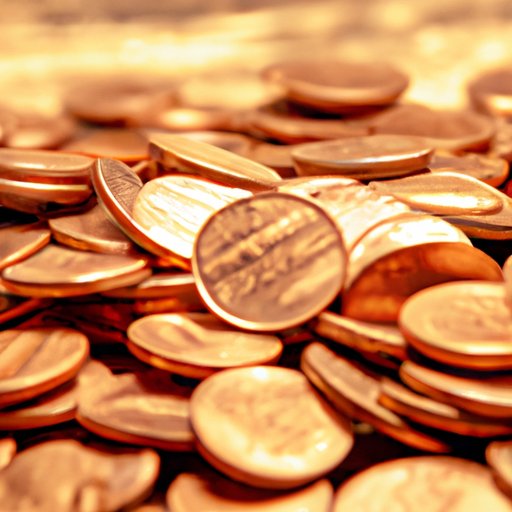
I. Introduction
Wheat pennies, also known as Lincoln cents, have been a popular coin for collectors for several decades. However, not all wheat pennies are created equal, and some can be worth a considerable amount of money. This article aims to explore the topic of wheat pennies and their value, with a focus on identifying which coins are most valuable and providing insight into the world of coin collecting. The target audience for this article is anyone interested in coins and the potential for profit in collecting them.
II. A Brief History of Wheat Pennies and their Value
Wheat pennies were first minted in 1909 to honor the centennial of Abraham Lincoln’s birth. They feature a portrait of Lincoln on the obverse side and two stalks of wheat on the reverse. Wheat pennies were minted until 1958, when they were replaced by the Lincoln Memorial design.
The value of a wheat penny is determined by several factors, including rarity, condition, and age. Older coins tend to be more valuable than newer ones, and coins with lower mintage numbers tend to be rarer and therefore more valuable. The condition of a coin is also important, with coins in better condition commanding higher prices.
Determining the value of a wheat penny can be a complex process. Collectors look at factors such as date, mintmark, and condition to assess a coin’s value. The most valuable wheat pennies are those with rare dates and mintmarks in excellent condition.
III. How to Identify Valuable Wheat Pennies
There are several key dates and mint marks that collectors look for when searching for valuable wheat pennies. These include:
- 1909-S VDB: This coin has a low mintage and is highly sought after by collectors. It features the initials “VDB” on the reverse side, which stand for the coin’s designer, Victor David Brenner.
- 1914-D: This coin has a low mintage and is one of the most valuable wheat pennies.
- 1922: This is a rare coin that was only minted in Denver and has no mintmark.
- 1931-S: This coin has a low mintage and is highly sought after by collectors.
- 1955 Doubled Die: This is a rare coin that features a doubled image of Lincoln on the obverse side.
In addition to these key dates and mint marks, collectors also assess a coin’s condition when determining its value. The higher the grade of the coin, the more it is worth. Coins that have been well-preserved and have no signs of wear and tear are the most valuable.
Other factors that can affect the value of a wheat penny include errors, such as double strikes or clipped planchets, and varieties, such as coins with repunched mintmarks or die varieties.
IV. Pros and Cons of Collecting Wheat Pennies
Collecting wheat pennies has several benefits, including their historical significance and potential for profit. Wheat pennies offer a glimpse into America’s past and provide collectors with a unique way to connect with history. Additionally, some wheat pennies can be worth a significant amount of money, making them a potentially lucrative investment.
However, there are also drawbacks to collecting wheat pennies. One of the biggest challenges is finding rare coins. Many valuable wheat pennies are extremely rare, making them difficult to find. Additionally, there is a risk of getting scammed when buying or selling wheat pennies, as not all sellers are reputable.
V. Where to Buy and Sell Wheat Pennies
There are several ways to buy and sell wheat pennies. Online marketplaces like eBay and Amazon offer a wide variety of coins for sale, as do specialty coin shops. Auctions can also be a good option for buying and selling coins, although the competition can be fierce, and prices can be high.
When buying or selling wheat pennies, it’s essential to do your research and make sure you’re dealing with a reputable seller. Look for sellers with good ratings and reviews, and beware of deals that seem too good to be true. It’s also a good idea to get coins graded by a professional grading service to ensure that you’re getting what you paid for.
VI. What To Do With Your Collection of Wheat Pennies
Once you’ve built up a collection of wheat pennies, there are several things you can do with them. Some collectors choose to hold onto their coins as a long-term investment, hoping that their value will increase over time. Others may choose to sell their coins for cash or trade them for other valuable coins.
Another option is to pass your collection down to future generations. Wheat pennies offer a unique connection to America’s past and can be a way to pass on your family’s history and legacy to your children and grandchildren.
VII. Conclusion
Wheat pennies can be a valuable and interesting addition to any coin collection. However, it’s essential to do your research and understand the factors that determine a coin’s value before investing in them. By learning how to identify valuable wheat pennies, where to buy and sell them, and what to do with your collection once you’ve amassed it, you can make the most of your investment and ensure that your coins remain a source of pride and enjoyment for years to come.




